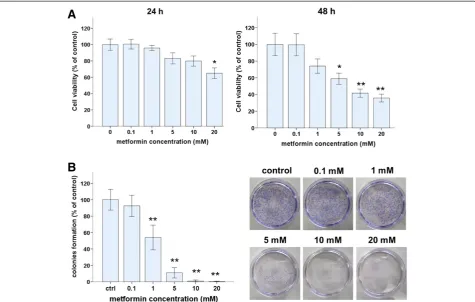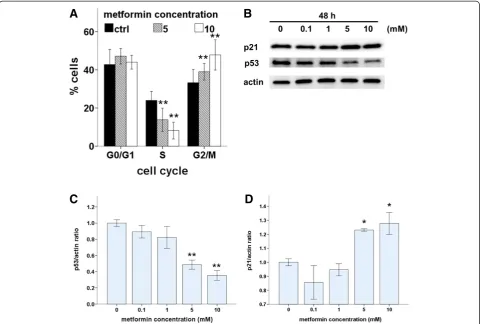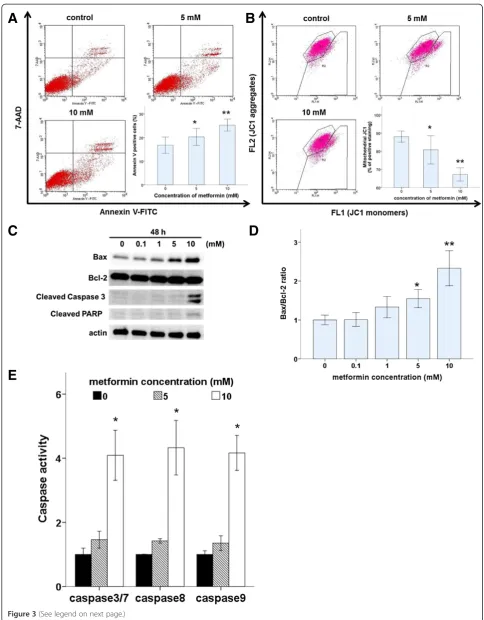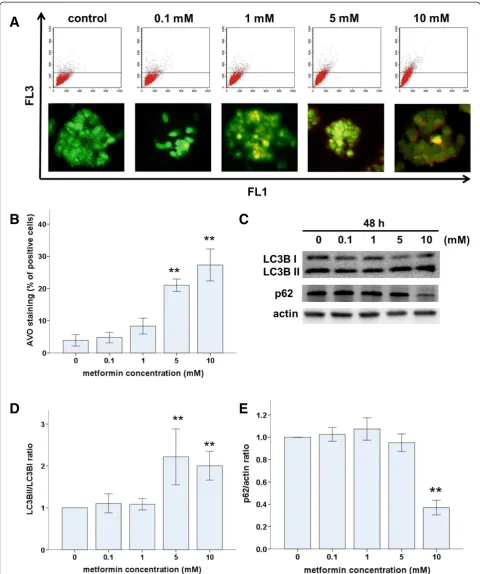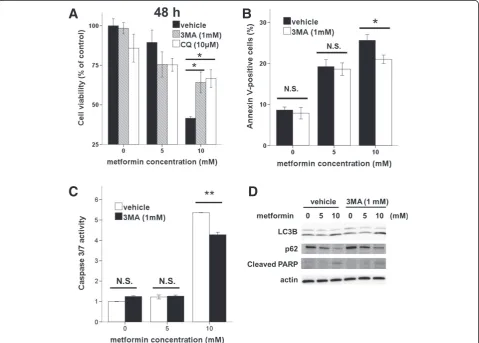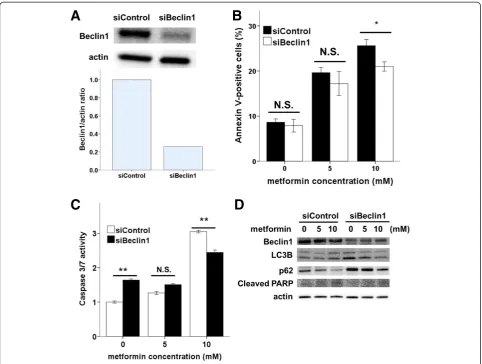P R I M A R Y R E S E A R C H
Open Access
Metformin impairs growth of endometrial cancer
cells via cell cycle arrest and concomitant
autophagy and apoptosis
Akimasa Takahashi
*, Fuminori Kimura, Akiyoshi Yamanaka, Akie Takebayashi, Nobuyuki Kita, Kentaro Takahashi
and Takashi Murakami
Abstract
Background:Effective therapies for early endometrial cancer usually involve surgical excision and consequent infertility Therefore, new treatment approaches that preserve fertility should be developed. Metformin, a well-tolerated anti-diabetic drug, can inhibit cancer cell growth. However, the mechanism of metformin action is not well understood. Here we investigate the roles of autophagy and apoptosis in the anti-cancer effects of metformin on endometrial cancer cells.
Methods:Ishikawa endometrial cancer cells were treated with metformin. WST-8 assays, colony formation assays, flow cytometry, caspase luminescence measurement, immunofluorescence, and western blots were used to assess the effects of metformin on cell viability, proliferation, cell cycle progression, apoptosis, and autophagy.
Results:Metformin-treated cells exhibited significantly lower viability and proliferation and significantly more cell cycle arrest in G1 and G2/M than control cells. These cells also exhibited significantly more apoptosis via both intrinsic and extrinsic pathways. In addition, metformin treatment induced autophagy. Inhibition of autophagy, either by Beclin1 knockdown or by 3-methyladenine-mediated inhibition of caspase-3/7, suppressed the anti-proliferative effects of metformin on endometrial cancer cells. These findings indicate that the anti-proliferative effects and apoptosis caused by metformin are partially or completely dependent on autophagy.
Conclusions:We showed that metformin suppresses endometrial cancer cell growth via cell cycle arrest and concomitant autophagy and apoptosis.
Keywords:Metformin, Endometrial cancer, Autophagy, Apoptosis
Background
Endometrial cancer is one of the most common gyneco-logic malignancies in the United States [1], and its inci-dence is rapidly increasing in Japan [2]. Approximately 80% of endometrial cancers are diagnosed at an early stage and are completely cured with hysterectomy [3,4]. In addition, approximately 25% of all cases are diagnosed in premenopausal women, and 3%–14% of all cases are diagnosed before 40 years of age [5-8]. Endometrial can-cer in young women poses a therapeutic dilemma be-cause preservation of fertility is often a major concern. Progesterone and medroxyprogesterone acetate are often
used to treat endometrial cancers in patients who desire to preserve their fertility [9]. Some younger women with endometrial cancer present with obesity, irregular menses, chronic anovulation, polycystic ovarian syndrome, insulin resistance, type 2 diabetes mellitus, or a combination [7,10]. Elimination of such conditions using low-dose cyclic pro-gestin may decrease recurrence orde novodevelopment of endometrial cancer. However, maintenance treatment with progestin prohibits pregnancy, and the therapeutic effect of progestin in endometrial cancers appears to be inadequate. Therefore, new approaches to the treatment and prevention of endometrial cancer must be developed for women trying to conceive.
The biguanide drug metformin is among the most pre-scribed drug for the treatment of type 2 diabetes worldwide. * Correspondence:akimasat@belle.shiga-med.ac.jp
Department of Obstetrics and Gynecology, Shiga University of Medical Science, Seta-Tsukinowa-cho, Otsu, Shiga 520-2192, Japan
Metformin (1,1-dimethylbiguanide hydrochloride) is a well-tolerated drug that has numerous cellular effects in mul-tiple tissues. The main anti-hyperglycemic effect is believed to be due to the suppression of hepatic glucose production [11]. In addition, metformin has been reported to inhibit the growth of various cancers [12-18], including endomet-rial cancer [19]. Metformin activates AMPK, a critical cellu-lar energy sensor. Activation of AMPK suppresses the mTOR; this cascade leads to reduced protein synthesis and cell proliferation [20]. In addition, higher doses of metfor-min (2–5 mM) reportedly induce apoptosis in endometrial cancer cell lines [20]. Whether metformin induces other forms of cell death such as autophagy is unknown.
Programmed cell death refers to any type of cell death mediated by an intracellular program [21]. Apoptosis is type-I programmed cell death, which is morphologically characterized by cell shrinkage, chromatin condensation, nuclear fragmentation, and formation of apoptotic bodies. Autophagic cell death is type-II programmed cell death, which is characterized by the accumulation of multi-lamellar vesicles that engulf the cytoplasm and organelles [22]. Apoptosis has long been known to play an important role in the response to several chemotherapeutic agents; however, the importance of treatment-induced autophagic cell death in tumor regression has only recently been rec-ognized [23,24]. Metformin induces apoptosis in some cancers [12,14,25] and autophagy in other, including mel-anoma, lymphoma, and colon cancer [12,17,18]. Multiple functional relationships between apoptosis and autophagy in cancer cells have been reported. Thus, a better un-derstanding of the interactions between apoptosis and autophagy may be a key to continued improvement of cancer treatments.
Here we used an endometrial cancer cell line to inves-tigate the anti-cancer activity of metformin. We focused on the role of autophagy and its effects on apoptotic cell death.
Methods
Reagents and antibodies
Metformin (1,1-dimethylbiguanide hydrochloride), 3-methyladenine (3MA), chloroquine (CQ), and siRNA were purchased from Sigma Aldrich (St. Louis, MI, USA). Anti-actin antibody was purchased from Sigma; all other anti-bodies were purchased from Cell Signaling Technology (Beverly, MA, USA). Modified Eagle’s medium (MEM), non-essential amino acids (NEAA), and trypsin/EDTA (0.25% trypsin, 1 mM EDTA) were purchased from Wako Pure Chemical Industries (Osaka, Japan). Antibiotics/anti-mycotics (ABAM) were purchased from Gibco (Carlsbad, CA, USA). Cell counting kit-8 (CCK-8) was purchased from Dojindo Laboratories (Tokyo, Japan). Caspase-Glo assay kits were purchased from Promega (Madison, WI, USA). FITC Annexin V apoptosis detection kit I, FITC
BrdU Flow Kit, and BD MitoScreen (JC-1) were pur-chased from BD Pharmingen (San Diego, CA, USA). Acridine orange (AO) was purchased from Molecular Probes (Eugene, OR, USA). Lipofectamine 2000 was purchased from Invitrogen (Carlsbad, CA, USA).
Cell culture, cell viability assay, and colony formation assay The Ishikawa human endometrial adenocarcinoma cell line was purchased from the European Collection of Cell Culture (ECACC, Salisbury, UK). Ishikawa cells were cul-tured in MEM supplemented with l-glutamine (2 mM), 5% (v/v) FBS, 1% NEAA, and ABAM at 37°C in a humidified atmosphere with 5% CO2.
We performed this work by using only cell line, but not clinical samples. Therefore, this work has been granted ex-emption from the Ethics Committee of Shiga University of Medical Science.
The WST-8 assay was used to measure cell viability. Cells were plated on 96-well plates at a density of 1 × 104cells/well in 100 μL medium. At 24 h after seeding, metformin (0, 0.01, 1, 5, 10, or 20 mM) was added to each well and cells were cultured for an additional 48 h. CCK-8 solution (10 μL) was then added to each well, and the plates were incubated at 37°C for 2 h. The ab-sorbance of WST-8 formazan was measured at 450 nm using a microplate reader.
To measure colony formation, adherent Ishikawa cells were trypsinized and 1000 viable cells (depending on the experiment) were subcultured in 60-mm plates; each treatment was tested in triplicate. After 24 h, the medium was replaced with fresh culture medium containing met-formin (0, 0.01, 1, 5, 10, or 20 mM) in a 37°C humidified atmosphere with 95% air and 5% CO2 and grown for 2 weeks. The culture medium was replaced every 3 days. Cell clones were stained for 15 min with a solution con-taining 0.5% crystal violet and 25% methanol in water. Stained cells were rinsed three times with tap water to remove excess dye. Each dish was then washed and dried, and the number of colonies/plate was macroscop-ically counted. Colonies were defined as those contai-ning >50 cells by microscopic examination.
Assessment of cell cycle, apoptosis, and mitochondrial membrane potential via flow cytometry
San Jose, CA, USA) was used to assess DNA content and cell cycle phase.
Annexin V-FITC apoptosis detection kits were used according to the manufacturer’s instructions to measure apoptosis. Cells were incubated with or without metfor-min for 48 h, collected and washed with PBS, gently re-suspended in annexin V binding buffer, and incubated with annexin V-FITC/7-AAD. Flow cytometry was per-formed using CellQuest Pro software (BD).
A mitochondrial membrane potential detection kit was used according to the manufacturer’s instructions to measure mitochondrial membrane potential (Δψm). In brief, cells were treated with or without metformin, re-suspended in 0.5 mL of JC-1 solution, and incubated at 37°C for 15 min. Cells were then rinsed before flow cy-tometry. A dot plot of red (living cells with intact Δψm) versus green fluorescence (cells lackingΔψm) was gener-ated. Data were expressed as the percentage of cells with intactΔψm.
Caspase activity
The Caspase-Glo™3/7, Caspase-Glo™8 or Caspase-Glo™ 9 assay kit was used according to the manufacturer’s in-structions to measure the activity of caspase 3/7, caspase-8 or caspase-9, respectively. In brief, 50 μL of cell lysate (cytosolic extracts, 20 μg) was incubated in 50 μL of Caspase-Glo reagent at room temperature for 1 h. After incubation, the luminescence of each sample was measured in a plate-reading luminometer (Tecan, Linz, Austria).
Detection and quantification of autophagic cells by staining with acridine orange
To identify autophagic cells, the volume of the cellular acidic compartment was visualized by AO staining [26]. Cells were seeded in 60-mm culture dishes and treated as described above. After 48 h of treatment with or with-out metformin, cells were incubated with medium con-taining 5 μg/mL AO for 15 min. The AO medium was then removed, cells were washed once with PBS, and fresh medium was added. Fluorescence micrographs were taken using an Olympus inverted fluorescence micro-scope (Olympus Corp., Tokyo, Japan). All images presented are at the same magnification. Flow cytometry was used to determine the number of cells with acidic vesicular or-ganelles (AVOs). Cells were trypsinized and harvested; BD FACSCalibur and BD CellQuest Pro software was used to analyze the cells. A minimum of 10,000 cells within the gated region was analyzed for each treatment.
RNA interference
Lipofectamine 2000 reagent and the Invitrogen protocol were used to introduce Beclin-1 siRNA (Sigma-Aldrich; seq1 #SASI_Hs02_00336256) or a scramble control
siRNA sequence (Sigma-Aldrich; #SIC001) into Ishikawa cells. Cells were then incubated for 48 h prior to metfor-min treatment (0, 5, or 10 mM).
Western blot analysis
Ishikawa cells (2 × 106/dish) were seeded in 100-mm cul-ture dishes and culcul-tured for 24 h. After metformin treat-ment, cells were lysed in RIPA lysis buffer containing a protease-inhibitor cocktail (“Complete” protease inhibi-tor mixture; Roche Applied Science, Indianapolis, IN) on ice for 30 min. Suspensions of lysed cells were centrifuged at 14 000 ×g at 4°C for 10 min; supernatants containing soluble cellular proteins were collected and stored at−80°C until use. BCA protein assay kits were used to measure protein concentration. Furthermore, 15 μg of protein was resuspended in sample buffer and separated on a 4%–20% tris-glycine gradient gel using the SDS-PAGE system. Re-solved proteins were transferred to PVDF membrane, which was blocked with 5% milk in tris-buffered saline/ 0.1% Tween 20. Immunodetection was performed using each primary antibody. The membranes were incubated with donkey anti-rabbit horseradish peroxidase (HRP)-conjugated secondary antibody (1:5000 dilution). The ECL Western Blotting Detection System (GE Health-care, Little Chalfont, UK) was used to detect signals, which were visualized using a LAS-4000 mini (GE Healthcare). Actin was used as the loading control.
Statistical analysis
All data points represent the mean of at least three inde-pendent measurements and are expressed as the mean ± standard deviation. SPSS ver. 20 was used to perform one-way ANOVA and Tukey’spost hoctest or Student’s t-test, as appropriate. A significance threshold of p < 0.05 was used.
Results
Metformin inhibits growth of Ishikawa endometrial cancer cells
WST-8 and colony formation assays were used to assess the effects of metformin on the viability of Ishikawa endometrial cancer cells. The number of viable cells de-creased with increasing concentrations of metformin for 24- or 48-h treatments (Figure 1A). After 24 h, 20 mM of metformin significantly reduced the number of viable cells but 0.01–10 mM metformin did not. After 48 h, metformin at 5 mM or more significantly reduced the number of viable cells. At 48 h, IC50 of metformin was 6.78 mM.
colony formation was dose dependent. Metformin at 5 mM or more reduced colony formation to 10% of that of untreated control cells. Based on these results and those in several published reports [13,17,27,28], 5 or 10 mM metformin was used in the following experiments.
Metformin induces cell cycle arrest and modulates cell cycle proteins in Ishikawa endometrial cancer cells To investigate the underlying mechanisms of metformin-induced growth inhibition in Ishikawa cells, we first evaluated the effect of metformin on cell proliferation and cell-cycle progression. Cell-cycle profiles were analyzed after 48 h of metformin treatment. There were significantly fewer S-phase cells and significantly more G2/M cells in metformin-treated cultures compared with those in control cultures, and these effects were dose dependent (Figure 2A). Furthermore, we used western blots to as-sess the effects of metformin on the expression of two cell cycle regulators, p53 and p21 (Figure 2B). Expression of p53 decreased in a dose-dependent manner with metformin treatment (Figure 2C). The induction of p21, a cell-cycle blocker, increased in a dose-dependent manner with met-formin treatment (Figure 2D). These results indicate that
metformin induced p21 expression, which led to cell cycle arrest in G1 and G2/M via a p53-independent pathway.
Metformin induces apoptosis of Ishikawa endometrial cancer cells via intrinsic and extrinsic pathways
To assess whether the induction of apoptosis also contrib-uted to metformin-mediated inhibition of Ishikawa cell growth, the proportion of apoptotic cells was measured. After cells were incubated with or without metformin (5 or 10 mM) for 48 h, the proportion of apoptotic cells was measured by flow cytometric of annexin V expression and JC-1 staining, which indicates the presence of a mito-chondrial membrane potential (Figure 3A and 3B). Our results demonstrate that the proportion of apoptotic cells was higher in metformin-treated cultures compared with that in controls.
To understand the mechanism by which metformin induced apoptosis in Ishikawa cells, we examined pro-apoptotic activity. Apoptosis can be activated through two main pathways: the intrinsic mitochondria-dependent pathway and the extrinsic death-receptor-dependent path-way. Caspase-8 is predominantly activated by signals from the extrinsic death-receptor pathway, while caspase-9
A
B
activation is dependent primarily on the intrinsic mito-chondrial pathway. Together, pro-apoptotic Bax and anti-apoptotic Bcl-2 play an important role in mitochondrial outer membrane permeabilization. Metformin treatment induced a marked, dose-dependent increase in the Bax/ Bcl-2 ratio (Figure 3D). Furthermore, metformin-mediated apoptotic death was accompanied by the activation of cas-pase, which is the principal apoptosis-executing enzyme. Fluorescence calorimetric analysis demonstrated that met-formin treatment induced the activation of caspase-3/7, -8, and -9 (Figure 3E). Consistent with the induction of apop-tosis, western blots revealed that metformin treatment led to cleavage of caspase-3 and PARP in Ishikawa cells in a dose-dependent manner (Figure 3C).
Metformin triggers autophagy in Ishikawa cells
To determine whether metformin induced autophagy in Ishikawa cells, we used AO to stain AVOs, including au-tophagic vacuoles. Untreated Ishikawa cells exhibited bright green fluorescence in the cytoplasm and nuclei and
lacked bright red fluorescence. In contrast, metformin-treated cells exhibited AVOs, identified as bright red compartments (Figure 4A). The number of AVOs was significantly higher in metformin-treated cells compared with that in untreated controls, and this effect was dose dependent (Figure 4A). Levels of LC3B (an autophago-some component) and p62 (an autophagoautophago-some target) positively and negatively correlate with autophagy, re-spectively. Therefore, we used western blots to assess LC3B-I to LC3B-II conversion and p62 protein levels. As expected, metformin treatment induced significant LC3 I to II conversion (Figure 4C and D) and a decrease in p62 levels (Figure 4C and E) in a dose-dependent manner. Taken together, these results demonstrate that metformin induced autophagy in Ishikawa cells.
Inhibition of autophagy reduced metformin-induced apoptosis in Ishikawa cells
To determine the relationship between apoptosis and au-tophagy in Ishikawa cells, we inhibited auau-tophagy either
A
B
C
D
A
C
E
D
B
pharmacologically (via 3MA or CQ) or genetically, and assessed the effects on metformin-mediated apoptosis. A WST-8 assay showed that 3MA and CQ treatment sig-nificantly enhanced the viability of metformin-treated (10 mM) cells (Figure 5A). On addition, flow cytometric analysis showed that 3MA treatment caused a marked decrease in the proportion of metformin-treated (10 mM) apoptotic cells (Figure 5B). Moreover, 3MA treatment caused a significant reduction in caspase activity in metformin-treated (10 mM) cells (Figure 5C). Thus, these findings revealed that inhibition of metformin-mediated autophagy reduced apoptosis in Ishikawa cells.
To confirm these results, we used siRNA to repress ex-pression of the autophagy regulator Beclin1 in Ishikawa cells. Beclin1 siRNA knocked down Beclin1 expression by approximately 75% (Figure 6A). Upon metformin treat-ment, significantly fewer Annexin-V-positive cells were observed in Beclin1siRNA cells compared with that in controls (Figure 6B). The inhibition of autophagy by Beclin1 siRNA resulted in decreases in caspase-3/7 activ-ity (Figure 6C), PARP cleavage, and LC3-II and increases in p62 (Figure 6D), as did pharmacologic inhibition of au-tophagy by 3MA (Figure 5D). These results demonstrate that the inhibition of autophagy reduced apoptosis associ-ated with metformin treatment.
Discussion
Recent data indicate that metformin may be a useful anti-proliferation agent for some types of cancer. The potential role of metformin in treating endometrial can-cer has been explored in a number of in vitro studies [19,29,30]. However, the anti-tumor effects of metformin are not completely understood. Furthermore, the effect of metformin on autophagy has not been investigated in endometrial cancer cells. Here we demonstrate that met-formin induced caspase-dependent apoptosis and sup-pressed proliferation by upregulating the cyclin-dependent kinase inhibitor p21 and inducing both G1 and G2/M arrest. In addition, we revealed that metformin pro-moted the formation of AVOs, the conversion of LC3-I to LC3-II, and the degradation of p62. Moreover, both pharmaco logic and genetic inhibition of autophagy re-duced metformin-inre-duced apoptosis. To the best of our knowledge, this is the first report to demonstrate that
metformin induces autophagy and that autophagy and apoptosis are linked processes.
Several studies have indicated that metformin treatment decreases cancer cell viability by inducing apoptosis. Can-trell et al. showed that metformin increased activation of caspase-3 in human endometrial cancer cells in a dose-dependent manner [19]. Hanna et al. suggested that met-formin induces apoptosis [20]. Similar to the results of these studies, we observed that metformin treatment of Ishikawa endometrial cancer cells induces a significant in-crease in apoptosis in a dose-dependent manner.
To elucidate the mechanism of metformin-induced apoptosis, we investigated mitochondrial function and caspase activity in Ishikawa cells. We observed that met-formin treatment altered the expression of Bcl-2 family proteins, PARP cleavage, and the activation of caspase-3/ 7, -8, and -9. Caspase-8 is essential for death-receptor-mediated apoptosis, while caspase-9 is essential for mitochondria-mediated apoptosis. These 2 pathways converge on caspase-3/7 activation, leading to subsequent activation of other caspases. Our results are similar to those of previous findings demonstrating that metformin induces significant increases in apoptosis in pancreatic cell lines and that metformin-induced apoptosis is associated with PARP cleavage, which is dependent on activation of caspase-3, -8, and -9 [14]. Thus, metformin may modulate apoptotic cell death via extrinsic and intrinsic pathways in Ishikawa cells.
In addition, metformin has been shown to induce ar-rest of the cell cycle in cancer cell lines [31]. Cantrell et al. showed that metformin induces G0/G1 cell cycle arrest in Ishikawa cells [19]. However, we observed that metformin blocked cell cycle progression not only in G0/G1 but also in the G2/M phase. This apparent dis-crepancy may result from differences in incubation time, pharmacologic dose or both. G0/G1 cell cycle arrest re-sulted from a 24-h incubation [19], and G0/G1 and G2/ M phase arrest resulted from a 48-h incubation. These findings suggest that metformin may block the cell cycle at two points. We observed that the cyclin-dependent kinase inhibitor p21, which plays an important role in cell-cycle arrest, was activated by metformin. Notably, p21 is among the genes most consistently induced by metformin [32]. Recent reports indicate that p21 is not (See figure on previous page.)
A
B
D
E
C
only a well-established negative regulator of the G1/S transition but also an inhibitor of the CDK1/cyclin B complex that maintains G2/M arrest [33,34]. These re-ports support our supposition that the G2/M phase cell cycle block occurs at 48 h.
Alternatively, it is possible that low doses of metformin cause G0/G1 arrest, whereas higher doses cause G2/M ar-rest. High metformin concentrations induce more p21 ex-pression; therefore, they may induce apoptosis of cells not only in G0/G1 but also in the G2/M cell cycle arrest. Moreover, p21 expression is induced by both p53-dependent and -inp53-dependent mechanisms. Mutations in the p53 gene are reportedly evident in >50% of all known cancer types. These mutations are recognized as one of the major events in carcinogenesis, and the Ishi-kawa cell line also has a p53 mutation [35]. Therefore, agents that induce p21 expression through a
p53-independent pathway may have potential as candidate drugs. Histone deacetylase (HDAC) inhibitors, such as Psammaplin A, suppress cell proliferation and induce apoptosis in Ishikawa cells via p53-independent upregu-lation of p21 expression [36]. Our results indicate that metformin treatment of Ishikawa cells increased p21 ex-pression but also decreased mutant p53 exex-pression. These findings also indicate that metformin-induced p21 expression may be regulated through a p53-independent mechanism. Therefore, we propose that metformin in-duces cell-cycle arrest in Ishikawa endometrial cancer cells both at G0/G1 and G2/M by activating p21 via a p53-independent pathway.
Autophagy is a process where the cytosol and organelles become encased in vacuoles called autophagosomes. Al-though autophagy is primarily a protective process for the cell, it can play a role in cell death [37]. Therefore,
A
B
C
D
autophagy is considered to be a double-edged sword. A recent work highlights the prosurvival role of autophagy in cancer cells [38]. Alternatively, autophagy may confer a disadvantage on cancer cells [12]. The variability in the effects of autophagy on cancer cells may depend on the cell type, cell cycle phase, genetic background, and microenvironment [39]. When the autophagic capacity of cancer cells is reached, apoptosis is promoted [40]. This finding is particularly interesting because metfor-min can induce autophagy in colon cancer and melan-oma [12,17], as well as Ishikawa endometrial cancer cells, as demonstrated here.
Metformin induced apoptosis and autophagy in Ishikawa endometrial cells. Because autophagy has been implicated in the promotion and inhibition of cell survival [21], we were interested in the role of autophagy in metformin-mediated apoptosis. To determine whether the processes of
autophagy and apoptosis are linked, we performed several experiments following the inhibition or induction of au-tophagy. We observed that both pharmacologic and genetic inhibition of autophagy promoted cancer cell survival and reduced metformin-induced apoptosis. In addition, our re-sults show that inhibition of autophagy decreased the cleav-age of PARP (Figure 5D and 6D) and the activation of caspase-3/7, -8, and -9 (data not shown). These findings in-dicate that inhibitors of autophagy enhanced both intrinsic and extrinsic activation of apoptosis. Taken together, these data suggest that metformin induces autophagic cell death in Ishikawa endometrial cancer cells. To the best of our knowledge, this is the first demonstration that metfor-min promotes the elimetfor-mination of endometrial cancer cells through concomitant regulation of autophagy and apoptosis. These results are based on in vitro studies only, and furtherin vivostudies are necessary.
A
C
D
B
Conclusions
We demonstrate that metformin is cytotoxic to Ishikawa endometrial cancer cells. Several mechanisms underlying the anti-tumor effects of metformin in Ishikawa cells are revealed by the data presented here. Metformin was shown to inhibit Ishikawa endometrial cancer cell prolif-eration through the induction of cell cycle arrest and caspase-dependent apoptosis and enhanced autophagic flux. In addition, we showed that pharmacological or genetic inhibition of autophagy decreased metformin-induced apoptotic cell death. These observations indi-cate that metformin may be a promising agent for the treatment of early endometrial cancer. In addition, our findings may provide insight into the role of autophagy in anti-cancer therapies.
Abbreviations
AMPK:Adenosine-monophosphate-activated protein kinase;
mTOR: Mammalian target of rapamycin; FITC: Fluorescein isothiocyanate; WST-8 assay: Modified 3-(4,5-dimethylthiazol-2-yl)-2,5-diphenyltetrazolium assay; 7-AAD: 7-Amino-Actinomycin D; FACS: Fluorescence activated cell sorting; AO: Acridine orange; AVOs: Acidic vesicular organelles; RIPA: Radioimmunoprecipitation assay buffer; PARP: poly (ADP-ribose) polymerase; CDK1: Cyclin-dependent kinase 1.
Competing interests
The authors declare that they have no conflicts of interest concerning the work presented here.
Authors’contributions
AT designed and performed research, analyzed data, and wrote manuscript; AT and AY assisted with flow cytomety analysis; FK assisted in witing and editing paper; NK, KT and TM assisted in research design, oversaw data analysis. All authors read and approved the final manuscript.
Acknowledgments
We thank the Central Research Laboratory of Shiga University of Medical Science for valuable technical assistance. The authors would like to thank Enago (www.enago.jp) for the English language review.
Received: 17 March 2014 Accepted: 11 June 2014 Published: 16 June 2014
References
1. Siegel R, Naishadham D, Jemal A:Cancer statistics, 2012.CA Cancer J Clin
2012,62(1):10–29.
2. Ushijima K:Current status of gynecologic cancer in Japan.J Gynecol Oncol
2009,20(2):67–71.
3. Rose PG:Endometrial carcinoma.N Engl J Med1996,335(9):640–649. 4. Amant F, Moerman P, Neven P, Timmerman D, Van Limbergen E, Vergote I:
Endometrial cancer.Lancet2005,366(9484):491–505.
5. Crissman JD, Azoury RS, Barnes AE, Schellhas HF:Endometrial carcinoma in women 40 years of age or younger.Obstet Gynecol1981,57(6):699–704. 6. Gallup DG, Stock RJ:Adenocarcinoma of the endometrium in women
40 years of age or younger.Obstet Gynecol1984,64(3):417–420. 7. Duska LR, Garrett A, Rueda BR, Haas J, Chang Y, Fuller AF:Endometrial cancer
in women 40 years old or younger.Gynecol Oncol2001,83(2):388–393. 8. Ota T, Yoshida M, Kimura M, Kinoshita K:Clinicopathologic study of
uterine endometrial carcinoma in young women aged 40 years and younger.Int J Gynecol Cancer2005,15(4):657–662.
9. Ehrlich CE, Young PC, Stehman FB, Sutton GP, Alford WM:Steroid receptors and clinical outcome in patients with adenocarcinoma of the
endometrium.Am J Obstet Gynecol1988,158(4):796–807.
10. Soliman PT, Oh JC, Schmeler KM, Sun CC, Slomovitz BM, Gershenson DM, Burke TW, Lu KH:Risk factors for young premenopausal women with endometrial cancer.Obstet Gynecol2005,105(3):575–580.
11. Viollet B, Guigas B, Sanz Garcia N, Leclerc J, Foretz M, Andreelli F:Cellular and molecular mechanisms of metformin: an overview.Clin Sci (Lond)
2012,122(6):253–270.
12. Buzzai M, Jones RG, Amaravadi RK, Lum JJ, DeBerardinis RJ, Zhao F, Viollet B, Thompson CB:Systemic treatment with the antidiabetic drug metformin selectively impairs p53-deficient tumor cell growth.Cancer Res2007,
67(14):6745–6752.
13. Gotlieb WH, Saumet J, Beauchamp MC, Gu J, Lau S, Pollak MN, Bruchim I:In vitro metformin anti-neoplastic activity in epithelial ovarian cancer.
Gynecol Oncol2008,110(2):246–250.
14. Wang LW, Li ZS, Zou DW, Jin ZD, Gao J, Xu GM:Metformin induces apoptosis of pancreatic cancer cells.World J Gastroenterol2008,
14(47):7192–7198.
15. Zhuang Y, Miskimins WK:Cell cycle arrest in Metformin treated breast cancer cells involves activation of AMPK, downregulation of cyclin D1, and requires p27Kip1 or p21Cip1.J Mol Signal2008,3:18.
16. Alimova IN, Liu B, Fan Z, Edgerton SM, Dillon T, Lind SE, Thor AD:
Metformin inhibits breast cancer cell growth, colony formation and induces cell cycle arrest in vitro.Cell Cycle2009,8(6):909–915. 17. Tomic T, Botton T, Cerezo M, Robert G, Luciano F, Puissant A, Gounon P,
Allegra M, Bertolotto C, Bereder JM, Tartare-Deckert S, Bahadoran P, Auberger P, Ballotti R, Rocchi S:Metformin inhibits melanoma development through autophagy and apoptosis mechanisms.Cell Death Dis2011,2:e199. 18. Shi WY, Xiao D, Wang L, Dong LH, Yan ZX, Shen ZX, Chen SJ, Chen Y, Zhao
WL:Therapeutic metformin/AMPK activation blocked lymphoma cell growth via inhibition of mTOR pathway and induction of autophagy.Cell Death Dis2012,3:e275.
19. Cantrell LA, Zhou C, Mendivil A, Malloy KM, Gehrig PA, Bae-Jump VL:Metformin is a potent inhibitor of endometrial cancer cell proliferation–implications for a novel treatment strategy.Gynecol Oncol2010,116(1):92–98.
20. Hanna RK, Zhou C, Malloy KM, Sun L, Zhong Y, Gehrig PA, Bae-Jump VL:
Metformin potentiates the effects of paclitaxel in endometrial cancer cells through inhibition of cell proliferation and modulation of the mTOR pathway.Gynecol Oncol2012,125(2):458–469.
21. Eisenberg-Lerner A, Bialik S, Simon HU, Kimchi A:Life and death partners: apoptosis, autophagy and the cross-talk between them.Cell Death Differ
2009,16(7):966–975.
22. Tanida I, Minematsu-Ikeguchi N, Ueno T, Kominami E:Lysosomal turnover, but not a cellular level, of endogenous LC3 is a marker for autophagy.
Autophagy2005,1(2):84–91.
23. Jing K, Song KS, Shin S, Kim N, Jeong S, Oh HR, Park JH, Seo KS, Heo JY, Han J, Park JI, Han C, Wu T, Kweon GR, Park SK, Yoon WH, Hwang BD, Lim K:
Docosahexaenoic acid induces autophagy through p53/AMPK/mTOR signaling and promotes apoptosis in human cancer cells harboring wild-type p53.Autophagy2011,7(11):1348–1358.
24. Wang N, Pan W, Zhu M, Zhang M, Hao X, Liang G, Feng Y:Fangchinoline induces autophagic cell death via p53/sestrin2/AMPK signalling in human hepatocellular carcinoma cells.Br J Pharmacol2011,164(2b):731–742. 25. Liu B, Fan Z, Edgerton SM, Deng XS, Alimova IN, Lind SE, Thor AD:
Metformin induces unique biological and molecular responses in triple negative breast cancer cells.Cell Cycle2009,8(13):2031–2040.
26. Paglin S, Hollister T, Delohery T, Hackett N, McMahill M, Sphicas E, Domingo D, Yahalom J:A novel response of cancer cells to radiation involves autophagy and formation of acidic vesicles.Cancer Res2001,61(2):439–444.
27. Luo Q, Hu D, Hu S, Yan M, Sun Z, Chen F:In vitro and in vivo anti-tumor effect of metformin as a novel therapeutic agent in human oral squamous cell carcinoma.BMC Cancer2012,12:517.
28. Kato K, Gong J, Iwama H, Kitanaka A, Tani J, Miyoshi H, Nomura K, Mimura S, Kobayashi M, Aritomo Y, Kobara H, Mori H, Himoto T, Okano K, Suzuki Y, Murao K, Masaki T:The antidiabetic drug metformin inhibits gastric cancer cell proliferation in vitro and in vivo.Mol Cancer Ther2012,11(3):549–560. 29. Xie Y, Wang YL, Yu L, Hu Q, Ji L, Zhang Y, Liao QP:Metformin promotes
progesterone receptor expression via inhibition of mammalian target of rapamycin (mTOR) in endometrial cancer cells.J Steroid Biochem Mol Biol
2011,126(3–5):113–120.
30. Zhang Z, Dong L, Sui L, Yang Y, Liu X, Yu Y, Zhu Y, Feng Y:Metformin reverses progestin resistance in endometrial cancer cells by
downregulating GloI expression.Int J Gynecol Cancer2011,21(2):213–221. 31. Ben Sahra I, Le Marchand-Brustel Y, Tanti JF, Bost F:Metformin in cancer
therapy: a new perspective for an old antidiabetic drug?Mol Cancer Ther
32. Rattan R, Giri S, Hartmann LC, Shridhar V:Metformin attenuates ovarian cancer cell growth in an AMP-kinase dispensable manner.J Cell Mol Med
2011,15(1):166–178.
33. Vermeulen K, Van Bockstaele DR, Berneman ZN:The cell cycle: a review of regulation, deregulation and therapeutic targets in cancer.Cell Prolif
2003,36(3):131–149.
34. Kawabe T:G2 checkpoint abrogators as anticancer drugs.Mol Cancer Ther
2004,3(4):513–519.
35. Murai Y, Hayashi S, Takahashi H, Tsuneyama K, Takano Y:Correlation between DNA alterations and p53 and p16 protein expression in cancer cell lines.Pathol Res Pract2005,201(2):109–115.
36. Ahn MY, Jung JH, Na YJ, Kim HS:A natural histone deacetylase inhibitor, Psammaplin A, induces cell cycle arrest and apoptosis in human endometrial cancer cells.Gynecol Oncol2008,108(1):27–33.
37. Mizushima N, Levine B, Cuervo AM, Klionsky DJ:Autophagy fights disease through cellular self-digestion.Nature2008,451(7182):1069–1075. 38. Amaravadi RK, Yu D, Lum JJ, Bui T, Christophorou MA, Evan GI,
Thomas-Tikhonenko A, Thompson CB:Autophagy inhibition enhances therapy-induced apoptosis in a Myc-induced model of lymphoma.
J Clin Invest2007,117(2):326–336.
39. Műzes G, Sipos F:Anti-tumor immunity, autophagy and chemotherapy.
World J Gastroenterol2012,18(45):6537–6540.
40. Maiuri MC, Zalckvar E, Kimchi A, Kroemer G:Self-eating and self-killing: crosstalk between autophagy and apoptosis.Nat Rev Mol Cell Biol2007,
8(9):741–752.
doi:10.1186/1475-2867-14-53
Cite this article as:Takahashiet al.:Metformin impairs growth of endometrial cancer cells via cell cycle arrest and concomitant autophagy and apoptosis.Cancer Cell International201414:53.
Submit your next manuscript to BioMed Central and take full advantage of:
• Convenient online submission
• Thorough peer review
• No space constraints or color figure charges
• Immediate publication on acceptance
• Inclusion in PubMed, CAS, Scopus and Google Scholar
• Research which is freely available for redistribution
